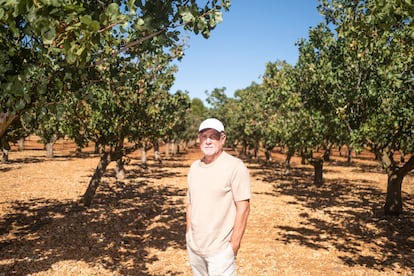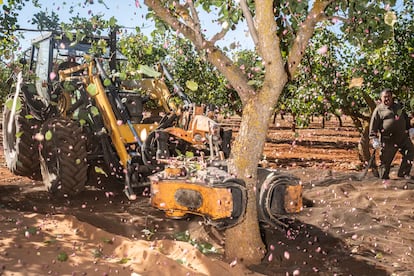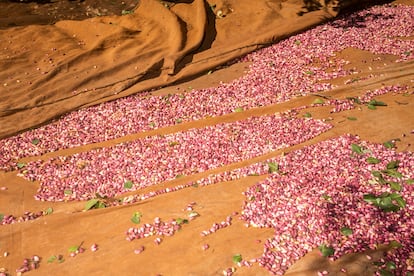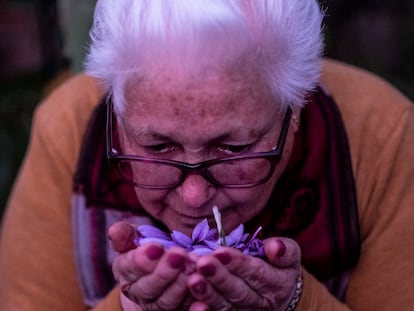The man who filled Spain with pistachios
In the land of olive trees and vineyards, one in every 700 square kilometers is now covered with this species, and one man started it all: agricultural engineer José Francisco Couceiro


A new kind of landscape can be observed over and over again around many communities in Spain. Where there had traditionally been vineyards, olive groves or fields of cereal, there are often pistachio orchards. One in every 700 square kilometers of the Spanish territory (the second-largest EU country with 505,990 km2 or 195,360 square miles) is already covered by this Asian species with long branches with leaves that turn red in the fall. The agricultural engineer José Francisco Couceiro, 65, is the individual who is chiefly responsible for the change. “I started this mess”, he thinks when he walks through the countryside. The early 20th-century writer Ramón María del Valle-Inclán used to say that the landscape gives rise to the language of its inhabitants and that language is the collective soul of the people. If this is true, the Spanish soul is changing.
In the shade of a huge pistachio tree on the outskirts of Ciudad Real, in central Spain, Couceiro can still recall the day in 1987 when a car full of agronomists stopped at this very spot. He was 29 years old and had just planted this tree as part of an experimental project at El Chaparrillo Agro-Environmental Research Center. The driver rolled down the window and asked, “What are they planting here?” “Pistachios,” a passenger answered from inside the car. “What bullshit!” the driver laughed before driving off. Couceiro recalls the anecdote with a triumphant smile. In two months he will retire, and according to his calculations he will leave behind some 70,000 hectares of pistachio trees planted under his impulse, in an area that would fit all of Singapore. It is more than a boom: the hectares have multiplied almost by 16 in the last decade.

In 1986 Couceiro, then a young man recently hired to work at El Chaparrillo, was asked to look for alternatives to the traditional crops of the vast plains of Spain’s Castilla-La Mancha region. “The first year I spent sending letters everywhere,” he recalls, producing a folder with the unusual answers he received. There are letters from Ayatollah Khomeini’s Iran, Saddam Hussein’s Iraq and Hafez al-Assad’s Syria. Couceiro, in basic English, asked unknown colleagues from countries with similar climates for information on crops that might grow well in his area. “Sometimes, in addition to kind answers in writing, I received pistachio buds wrapped in wet paper. When the grafts worked, we would have a party,” he recalls.
For a decade Couceiro worked “in solitude and silence” in the empty plains of Ciudad Real. “It was totally quixotic. I was alone for 10 years, absolutely alone, here with the pistachios,” he says. The engineer and his small team, after many failed experiments, came up with a magic formula: use the trunk of a native tree, the cornicabra, and graft on it the most successful pistachio varieties from Iran. Those Spanish trunks with Iranian branches can produce up to a ton of pistachios per hectare of dry land per year, an amount valued at around €6,000 at the price of the last harvest. These are unheard-of profit margins.

When Couceiro started promoting the pistachio, growers were very skeptical. Ladislao López, a winegrower, began working at El Chaparrillo in 1993 and still remembers his astonishment when he saw the engineer’s crops: “I thought he was crazy. I had never seen a pistachio in my life.” In those early years, this public center run by the regional government decided to give away buds of the Iranian varieties of pistachio trees to anyone who wanted them. Many of the courageous souls who took the leap later reaped the benefits in spades. Now, Couceiro laments, the public institution is in the background and a handful of large companies have taken the reins of the sector.
Investment funds have set their sights on agriculture. In the town of Malpica de Tajo, in Toledo province, the Portuguese company Treemond Holding, under the guidance of the investment bank GBS Finance, bought 1,000 hectares of vineyards from the Osborne Group two years ago to uproot the vines and plant pistachio trees. “Many soccer players,” says Couceiro, are investing in this crop. One of them, Gabi Fernández, a former Atlético de Madrid player, has said so publicly. And the regional bank Globalcaja has been proclaiming for years that pistachio is “the new green gold.”

Couceiro predicts a disaster. He continues to recommend using the native cornicabra tree as a trunk on which to graft Iranian pistachio branches. However, the large estates owned by the investment funds are copying the ultra-intensive model of California, where a tree with a cold name is used as a base, the UCB-1, named after the acronym of the American institution that created it through hybridization: the University of California at Berkeley. These are trees that grow very fast but, in the shallow Spanish soils, their roots spread out to the sides and compete with each other. “It’s as if we have a lemon slushy and 10 people are slurping on it. Imagine how much we each get,” illustrates Couceiro. “Ambition is good. Greed is bad.”
The researcher also predicts that pistachio trees will be pulled out “in massive amounts” in the next five to 10 years, possibly a third or as much as half of the current 70,000 hectares. Many trees, he argues, have been poorly chosen or planted in unsuitable regions. Couceiro stresses that pistachio trees need very hot summers, cold winters and a very dry environment, as occurs in Castilla-La Mancha and inland Andalusia. “Humidity is poison for pistachios, but growers are being told that pistachios can be placed anywhere,” warns the engineer, who is currently attached to the Castilla-La Mancha Regional Institute for Research and Development of Agro-Food and Forestry. “There are pistachio plantations even in [the northern, rainy region] Galicia and in El Bierzo!” exclaims Couceiro.

Pistachio trees are slow to bear fruit, taking about six years to produce their first major harvest, so planting errors are identified when it is already too late. It’s a time bomb. “The UCB-1 and the cornicabra are like a dinosaur and a cow. Who is going to die first? The dinosaur or the cow? The dinosaur, because it needs five or 10 times more than the cow,” argues Couceiro. California, with deeper soils, an optimal climate and heavy use of fertilizers and phytosanitary products, can more easily maintain these plant dinosaurs. Without enough food, however, these very vigorous trees produce closed pistachios. If the grower makes a mistake, he realizes when he has already lost 10 years of work.
There was a scientist in Spain who focused on the pistachio even before Couceiro: the agricultural engineer Francisco Vargas, who today is 77 years old and retired. Vargas planted the first pistachio tree in 1975 on a farm in Tarragona that belonged to the Catalan Institute of Agrifood Research and Technology. In a telephone interview, Vargas recalled how the first experiments were “a disaster” and his bosses soon decided to swich to almonds, with great success. The varieties of almond trees created by Vargas have sold by the millions. “In Castilla-La Mancha, Couceiro and his colleagues focused on pistachios and they are the ones who have expanded it enormously,” applauded Vargas.
Sitting between piles of papers in his laboratory, Couceiro talks wearily, two months ahead of his retirement. “For me, on December 1 the pistachio will be over forever. And when I say forever, I mean forever. I don’t want to know anything more about pistachios. I can see that this is all going to hell.” At the end of the working day, Couceiro drives over to pick up his wife Marina Rodríguez de Francisco, who is also an agricultural engineer. Together they wrote the chapter dedicated to cooking recipes in the monumental 2013 work El cultivo del pistacho (or Pistachio Cultivation). The 700-plus-page volume shows readers how to prepare pistachio salads, pistachio croquettes, spaghetti with pistachios, squid stuffed with pistachios, lamb casserole with pistachios, and pistachio ice cream. “We spent four months eating pistachios.”
Tu suscripción se está usando en otro dispositivo
¿Quieres añadir otro usuario a tu suscripción?
Si continúas leyendo en este dispositivo, no se podrá leer en el otro.
FlechaTu suscripción se está usando en otro dispositivo y solo puedes acceder a EL PAÍS desde un dispositivo a la vez.
Si quieres compartir tu cuenta, cambia tu suscripción a la modalidad Premium, así podrás añadir otro usuario. Cada uno accederá con su propia cuenta de email, lo que os permitirá personalizar vuestra experiencia en EL PAÍS.
¿Tienes una suscripción de empresa? Accede aquí para contratar más cuentas.
En el caso de no saber quién está usando tu cuenta, te recomendamos cambiar tu contraseña aquí.
Si decides continuar compartiendo tu cuenta, este mensaje se mostrará en tu dispositivo y en el de la otra persona que está usando tu cuenta de forma indefinida, afectando a tu experiencia de lectura. Puedes consultar aquí los términos y condiciones de la suscripción digital.









































